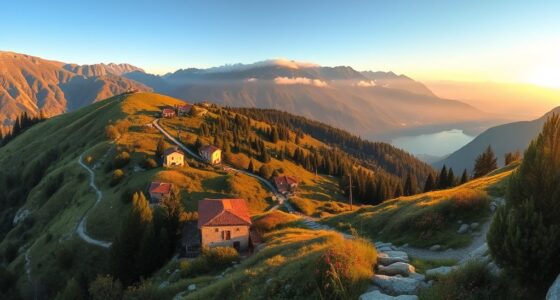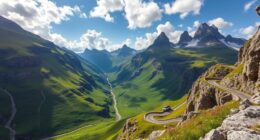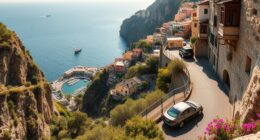On Argentina’s Route 40 in the north, you’ll experience vibrant cities like Salta with its colonial charm, and explore UNESCO-listed Quebrada de Humahuaca, famous for its colorful landscapes and indigenous heritage. Discover charming villages, breathtaking landscapes in the Calchaquí Valleys, and ancient ruins such as Quilmes. Immerse yourself in lush Yungas forests and lively local cultures. Continue exploring to uncover the region’s natural wonders, cultural traditions, and unforgettable adventures, all woven into your journey.
Key Takeaways
- Explore the colorful Quebrada de Humahuaca with its dramatic cliffs, vibrant landscapes, and indigenous cultural festivals.
- Discover the Calchaquí Valleys’ red and yellow hues, scenic vineyards, and traditional festivals celebrating local heritage.
- Visit archaeological sites like the Quilmes ruins to learn about indigenous craftsmanship and ancient social structures.
- Experience the region’s geological wonders, including unique rock formations, high-altitude landscapes, and mineral-rich layers.
- Engage with local communities to enjoy authentic crafts, regional cuisine, and vibrant cultural traditions along Route 40.
The Vibrant City of Salta and Its Colonial Charm
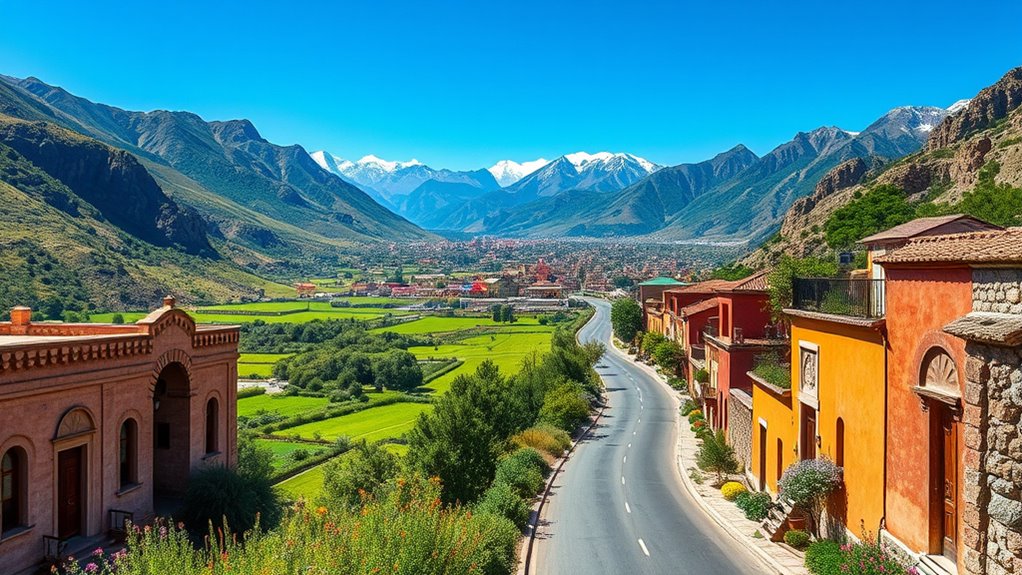
Nestled in the foothills of the Andes, Salta bursts with colonial architecture and lively streets that invite exploration. As you walk through its colonial streets, you’ll notice the vibrant colors and intricate details of historic buildings, showcasing Salta architecture at its finest. The city’s architecture reflects a rich history, blending Spanish colonial influences with local craftsmanship. Bright facades, ornate balconies, and cobblestone lanes create an authentic atmosphere that feels like stepping back in time. You’ll find plazas bustling with cafes and markets, perfect for soaking in the local culture. The charm of Salta’s colonial streets makes it easy to get lost in its historical allure, offering a fascinating glimpse into Argentina’s colonial past. Additionally, indigenous craftsmanship can often be seen in the decorative elements of many buildings, highlighting local artistic traditions. Exploring the city’s historic sites and their architectural details provides a deeper appreciation for its cultural legacy. Notably, these structures often incorporate local artistic traditions, which add to their unique character. Moreover, the preservation of these architectural features demonstrates the city’s commitment to cultural heritage conservation. Furthermore, the integration of sound healing science techniques in restoration projects is emerging as a way to promote the well-being of the community while preserving historical integrity.
Quebrada De Humahuaca: a UNESCO World Heritage Site
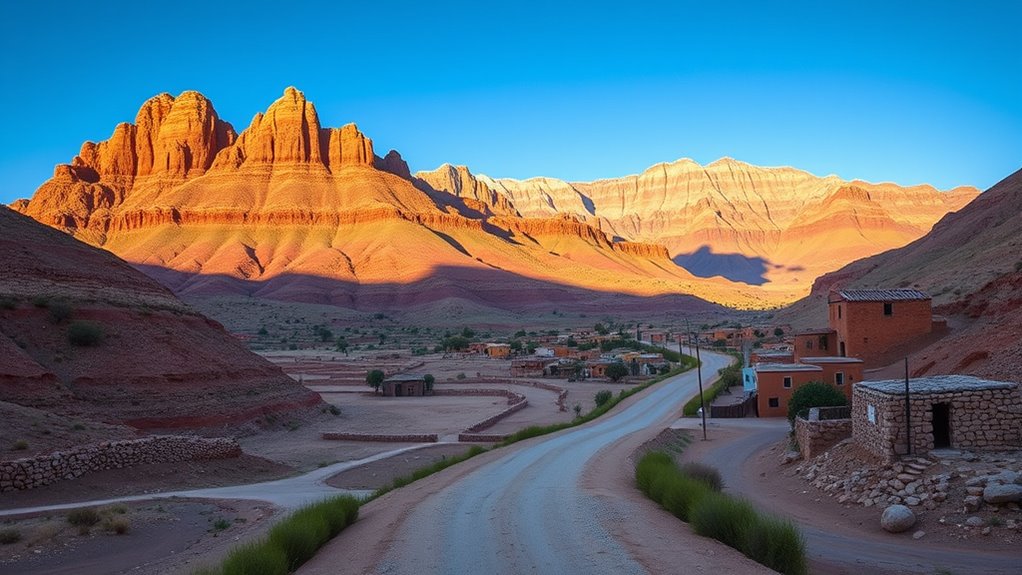
As you explore Quebrada de Humahuaca, you’ll notice its vibrant cultural heritage reflected in colorful villages and ancient traditions. The breathtaking natural landscapes, with towering cliffs and winding valleys, create a stunning backdrop at every turn. This UNESCO site offers a perfect blend of rich history and striking scenery that leaves a lasting impression. To enhance your experience, consider visiting local markets that showcase traditional crafts and regional farmhouse decor to gain insight into rural Argentine aesthetics. Incorporating craft and textiles into your travel experience can also enrich your understanding of local food traditions and healthy eating practices. Learning about cultural heritage can deepen your appreciation of the area’s unique identity and history. Exploring local artisan techniques can provide a more comprehensive view of the region’s creative expressions and historical influences.
Vibrant Cultural Heritage
Have you ever wondered what makes the Quebrada de Humahuaca a UNESCO World Heritage Site? It’s the vibrant cultural heritage that shines through local arts and culinary traditions. As you explore, you’ll notice colorful markets filled with handmade crafts, textiles, and jewelry reflecting indigenous influences. The region’s art tells stories of history and identity, celebrated through murals and performances. Don’t miss tasting traditional dishes like tamales, humita, and empanadas, which showcase unique flavors passed down through generations. These culinary traditions aren’t just about food—they’re expressions of community and history. The lively festivals and music scene further highlight the area’s rich cultural tapestry. Here, every corner offers a glimpse into a thriving heritage that continues to shape local life today. Additionally, understanding the cultural heritage of the region can deepen your appreciation of its significance. Exploring the local building traditions can also provide insight into the region’s sustainable and adaptive architectural practices. Recognizing the influence of electric power generation methods reveals how communities sustain their cultural sites and daily life. Furthermore, embracing innovative technologies can help preserve these traditions for future generations. Incorporating sustainable practices in local development ensures the preservation of cultural and environmental integrity.
Stunning Natural Landscapes
The Quebrada de Humahuaca captivates visitors with its breathtaking natural landscapes that stretch across the highlands of northern Argentina. As you explore, you’ll be surrounded by stunning mountain panoramas and rich flora diversity that thrive in this arid region. The vibrant colors of the hills and cliffs create a mesmerizing backdrop for your journey. To fully enjoy this area, consider:
- Admiring the dramatic mountain formations that showcase natural artistry.
- Observing the unique flora that adapts to the high-altitude environment.
- Visiting viewpoints to capture panoramic vistas of the rugged landscape.
These natural features make the Quebrada de Humahuaca a true highlight, offering an awe-inspiring experience of Argentina’s spectacular scenery.
The Enchanting Villages of the Jujuy Province
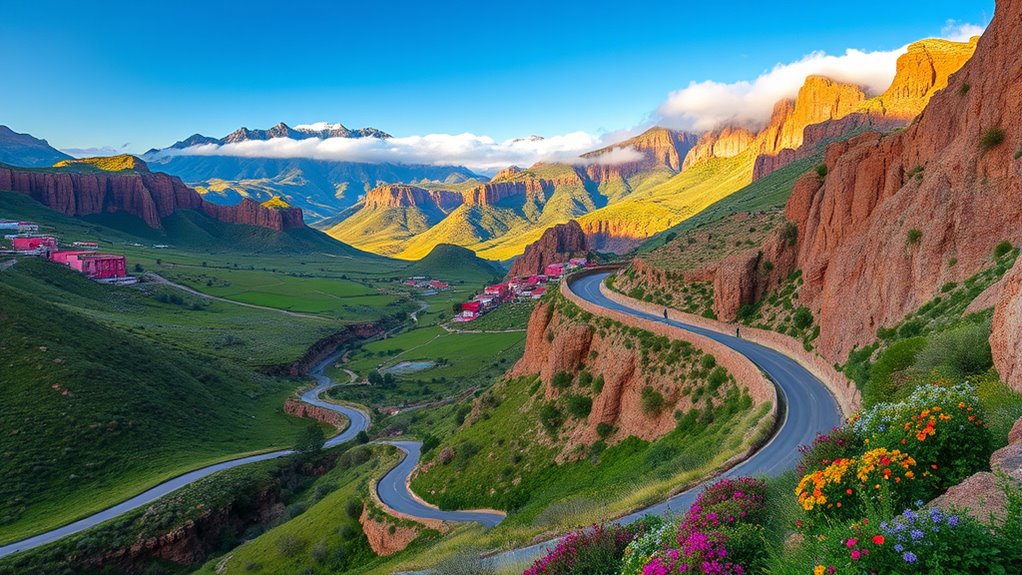
Nestled amid the breathtaking landscapes of Jujuy Province, its villages exude a unique charm that captures every visitor’s heart. As you wander through these villages, you’ll notice the vibrant traditions alive in the form of traditional crafts. Artisans craft intricate textiles, pottery, and jewelry, showcasing skills passed down through generations. Local festivals enliven the villages, featuring lively dances, colorful costumes, and music that celebrate their rich cultural heritage. These events offer a genuine glimpse into daily life and traditions, making your visit even more memorable. You’ll find that the warmth of the villagers and their dedication to preserving their customs create an authentic, enthralling atmosphere. Exploring these villages provides a captivating journey into Jujuy’s vibrant culture and craftsmanship, especially considering the region’s cultural heritage preservation efforts. Additionally, the integration of Cultural Intelligence into local tourism initiatives helps visitors better understand and appreciate these diverse cultural expressions. Moreover, efforts to promote community involvement play a crucial role in sustaining these traditions for future generations. By supporting local artisans and participating in community activities, visitors contribute to the ongoing tradition preservation and cultural vitality of the area. Incorporating educational programs can further enhance visitors’ appreciation and understanding of the cultural significance behind these crafts and festivals.
Stunning Landscapes at the Calchaquí Valleys
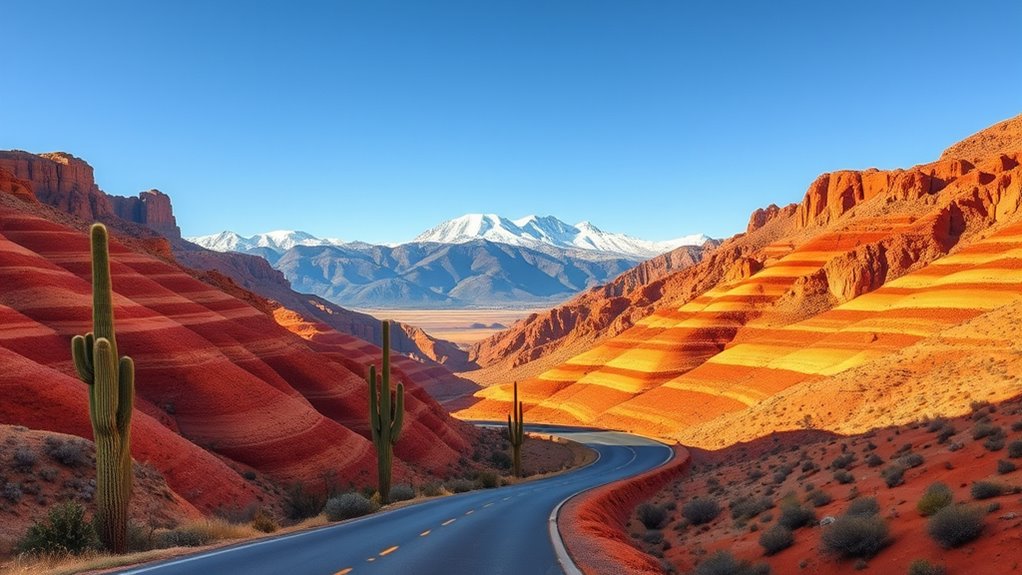
As you explore the Calchaquí Valleys, you’ll notice the vibrant colors that paint the landscape, shifting with the changing sunlight. The area’s unique geological formations create dramatic cliffs and valleys that seem almost otherworldly. You’ll also encounter a rich indigenous heritage that adds depth and meaning to these stunning surroundings. For a truly immersive experience, engaging with local indigenous traditions can deepen your appreciation of the region’s cultural significance. For those interested in coffee, trying a French Press during your travels can offer a rich, full-bodied taste, perfect for enjoying the scenic vistas. Incorporating inflation protection features in your financial planning can help ensure your investments maintain their value over time. Maintaining emotional well-being during travel can enhance your overall experience and enjoyment of the journey.
Vibrant Valley Colors
When you explore the Calchaquí Valleys, you’ll be captivated by the striking palette of vibrant colors that paint the landscape. The mix of deep reds, golden yellows, and lush greens creates a stunning backdrop for your journey. These colors aren’t just beautiful—they reflect the region’s rich soil and diverse vegetation, perfect for agriculture tourism. During valley festivals, you’ll see locals celebrating with lively music and traditional dances amid these vivid hues, enhancing your cultural experience. To fully enjoy this visual feast, consider these highlights:
- Admire the colorful vineyards and orchards thriving in the valley.
- Attend festivals showcasing vibrant textiles and crafts.
- Capture breathtaking photos of the multicolored landscape at sunrise and sunset.
Unique Geological Formations
The Calchaquí Valleys boast some of the most striking geological formations in Argentina, shaping the breathtaking landscapes that surround you. These formations are the result of intense geothermal activity over millions of years, creating dramatic cliffs, deep canyons, and unusual rock structures. You’ll notice mineral deposits that have accumulated in certain areas, forming colorful layers and unique patterns on the landscape. The landscape’s rugged beauty is a testimony to natural forces shaping the region’s geology. As you explore, you’ll see how volcanic activity and mineral-rich sediments have contributed to the valleys’ distinctive features. These geological wonders not only define the scenery but also tell a story of Earth’s dynamic history, making your journey through the Calchaquí Valleys truly mesmerizing.
Rich Indigenous Heritage
Nestled within the stunning landscapes of the Calchaquí Valleys, the rich Indigenous heritage comes alive through ancient sites, vibrant traditions, and enduring customs. You can explore how indigenous storytelling preserves history and cultural identity, offering vivid tales passed down through generations. The region also showcases traditional crafts, like intricate weaving and pottery, which reflect ancestral techniques and artistry. Engaging with local communities, you’ll witness firsthand the importance of these practices in daily life. To deepen your appreciation, consider these highlights:
- Discover ancient petroglyphs and archaeological sites that tell stories of past civilizations.
- Watch artisans creating traditional crafts, blending history with contemporary expression.
- Experience local storytelling sessions that bring Indigenous legends and customs to life, connecting you to the region’s deep-rooted heritage.
The Historic Ruins of Quilmes and Indigenous Heritage
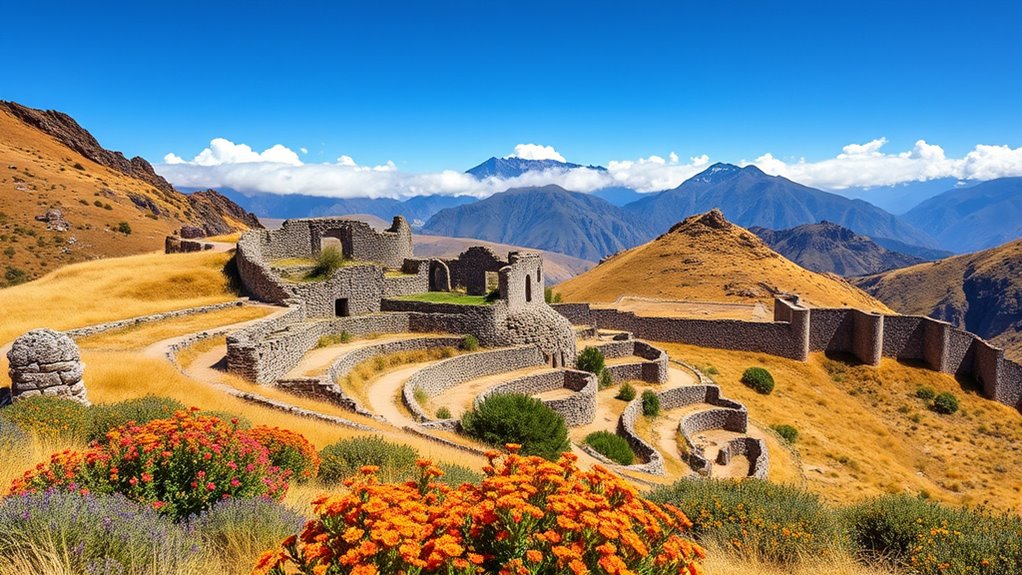
Exploring the historic ruins of Quilmes offers a mesmerizing glimpse into Argentina’s indigenous heritage. As you walk through the ancient stone structures, you’ll see remnants of their skilled craftsmanship, including ancient pottery and signs of indigenous art. These ruins reveal how the Quilmes people built their community, preserving their cultural identity despite outside influences. The site provides insight into their daily life, social organization, and spiritual practices. You might notice intricate designs on pottery shards, reflecting their artistic expression. Learning about their resilience and cultural traditions helps you appreciate the richness of indigenous history in the region. Visiting these ruins connects you directly with a proud heritage that endured centuries, making it a meaningful stop along your journey along Route 40.
Unique Natural Wonders of the Yungas Forests

As you venture into the Yungas forests, you’ll encounter a breathtaking tapestry of natural wonders that thrive amidst lush greenery and rugged terrain. The region’s biodiversity is astonishing, with countless plant and animal species unique to these cloud forest ecosystems. You’ll be amazed by the vibrant flora and fauna that flourish here. To help you appreciate this natural marvel, consider these highlights:
- The diverse birdlife, including colorful toucans and hummingbirds, soaring through the canopy.
- The ancient, towering trees that create a mystical, mist-covered environment.
- Hidden waterfalls and streams that carve through the dense forest, adding to the area’s enchantment.
Exploring these wonders reveals the extraordinary natural richness of the Yungas forests.
The Cultural Richness of Tucumán’S Capital, San Miguel De Tucumán
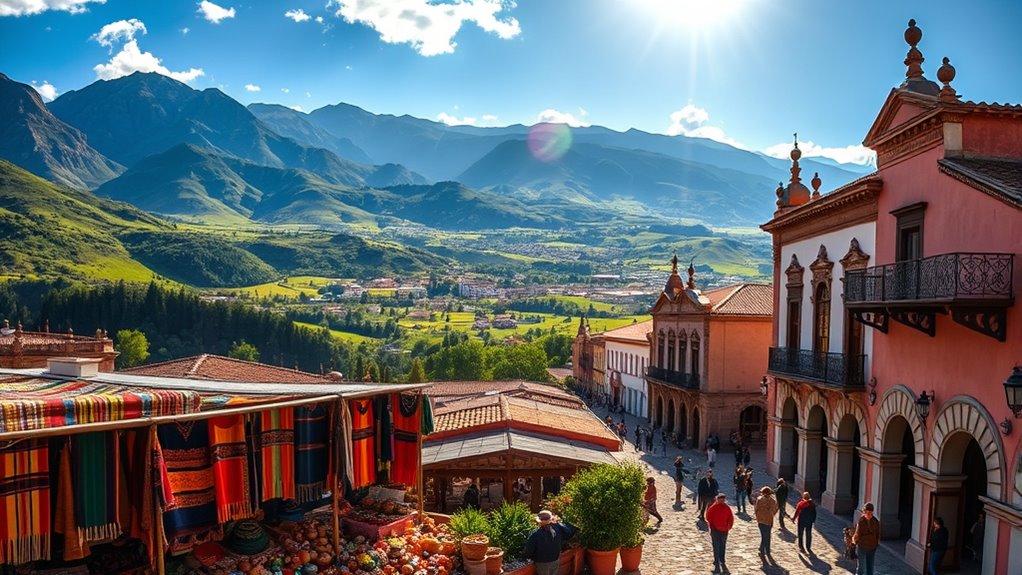
San Miguel de Tucumán pulses with a vibrant cultural scene that reflects its rich history and diverse heritage. As you explore the city, you’ll discover lively streets filled with local cuisine that combines indigenous flavors with Spanish influences, offering dishes you won’t forget. Music plays a central role here, with traditional music echoing through plazas and cafes, creating a lively, authentic atmosphere. You can enjoy performances of folk dances and melodies that have been passed down through generations. The city’s museums, historic sites, and bustling markets showcase its cultural depth, inviting you to immerse yourself in Tucumán’s unique identity. Whether through its flavors or its sounds, San Miguel de Tucumán invites you to experience its vibrant cultural heartbeat firsthand.
Adventure Opportunities in the Lerma Valley and Surroundings
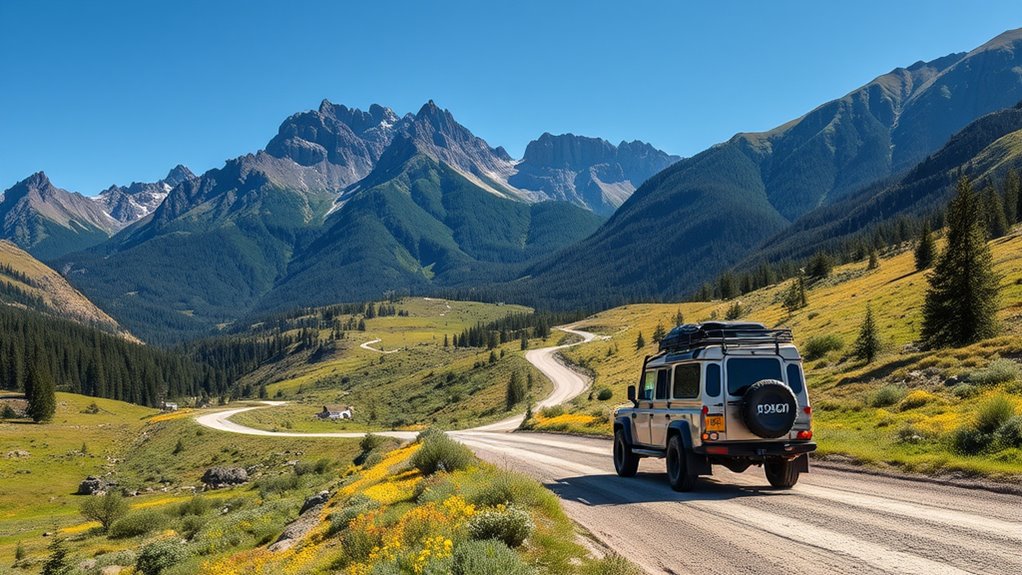
Nestled in the heart of northwest Argentina, the Lerma Valley and its surroundings offer a wealth of adventure opportunities for thrill-seekers and nature lovers alike. You can explore stunning landscapes through Lerma Valley hiking, taking in panoramic views of mountains, valleys, and lush vineyards. For a more relaxed experience, indulge in wine tasting experiences at local wineries, where you’ll savor regional Malbecs and Torrontés. If you’re seeking excitement, consider mountain biking along scenic trails or trying paragliding over the valley’s breathtaking scenery. The area also offers opportunities for horseback riding through vineyards and orchards, immersing you in the natural beauty and local culture. Here are some highlights to enjoy:
- Lerma Valley hiking trails
- Wine tasting at local vineyards
- Mountain biking adventures
Local Flavors and Traditions Along the Route
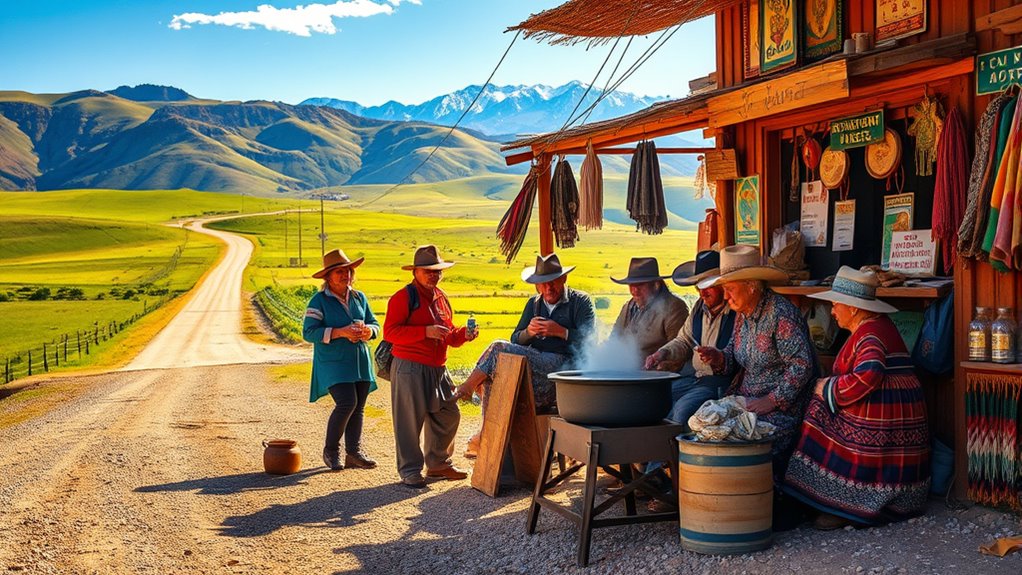
Traveling along Route 40, you’ll encounter a vibrant tapestry of local flavors and traditions that deeply reflect the region’s rich cultural heritage. You can savor authentic local cuisine, from hearty stews and grilled meats to regional cheeses and wines that highlight Argentina’s culinary diversity. As you explore, you’ll also discover traditional crafts crafted by local artisans, such as colorful textiles, pottery, and woodwork, showcasing generations of skilled craftsmanship. These crafts often carry cultural stories and regional symbolism, adding depth to your experience. Engaging with local communities gives you a chance to taste their dishes and learn about their customs firsthand. This blend of flavors and traditions makes your journey along Route 40 not just scenic, but also a deep immersion into Argentina’s cultural soul.
Frequently Asked Questions
What Is the Best Time of Year to Travel Along Argentina’S Route 40?
The best season for your trip depends on weather considerations and your preferences. Typically, spring (October to December) and fall (March to May) offer mild temperatures and fewer crowds, making travel more enjoyable. Summer can be hot, especially in northern regions, while winter might bring colder temperatures and some snow. Choose your timing based on whether you prefer warm weather, avoiding rain, or exploring in cooler, quieter months for a more relaxed experience.
Are There Guided Tours Available for Route 40’S Northern Highlights?
Did you know that over 150 guided tours operate along Argentina’s Route 40? You’ll find plenty of options offered by local operators, making it easy to explore without the hassle of planning. Guided tours cover key highlights, provide cultural insights, and guarantee safety. Whether you prefer day trips or multi-day adventures, local operators can customize your experience, helping you discover the stunning landscapes and unique attractions along the route.
How Accessible Are the Remote Villages and Natural Sites Along Route 40?
You’ll find that remote access to villages and natural sites varies; some spots are quite accessible, while others require careful planning. Transportation options like local buses, taxis, or organized tours can help, but expect limited services in the most remote areas. It’s best to prepare in advance, considering your transportation choices, to guarantee you can explore comfortably and safely along the route.
What Safety Tips Should Travelers Keep in Mind on Route 40?
When considering travel safety along Route 40, stay alert to changing road conditions, especially on remote or less-maintained sections. Always drive carefully, obey speed limits, and avoid distractions. Keep essentials like water, a first aid kit, and a charged phone in case of emergencies. It’s also wise to verify weather updates beforehand, plan your stops, and inform someone about your itinerary. These tips help guarantee a safe and enjoyable journey.
Are There Accommodations Suitable for All Budgets Along the Route?
You’ll find accommodations for every budget along the route, from budget-friendly hostels and cozy inns to luxury lodges that feel like palaces. Whether you want to save or indulge, there’s something perfect for you. Budget options offer comfort without breaking the bank, while luxury lodges provide top-tier amenities. No matter your choice, you’ll enjoy a warm stay that makes your journey as unforgettable as the breathtaking scenery surrounding you.
Conclusion
As you journey along Argentina’s Route 40, each destination becomes a chapter in your story, like threads weaving a vibrant tapestry. The mountains, valleys, and ancient ruins symbolize resilience and discovery, inviting you to embrace the spirit of adventure and cultural richness. Let this route be your compass, guiding you through a landscape that’s as timeless as the stars, inspiring your soul to explore beyond the horizon and find your own path of wonder.





